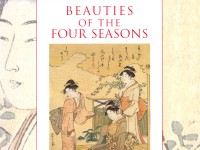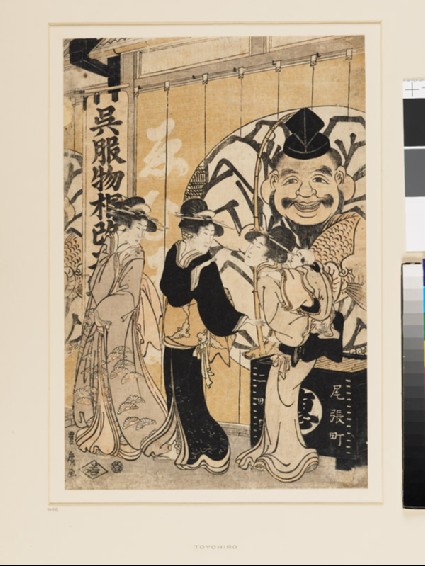Beauties of the Four Seasons
A full catalogue of the Ashmolean’s collection of Japanese bijinga (beautiful women) prints by Mitsuko Watanabe (published Oxford, 2005).

Publications online: 54 objects
Women outside the Ebisuya emporium
-
Literature notes
The two beauties depicted on the left have probably just met with the other woman with child on her back by chance in front of the emporium, Ebisu-ya. The Ebisu-ya was one of the biggest mercers in Owari-chō in Edo, which lies in Ginza 4-chōme of present-day Tokyo. The curtain behind them shows a large head of Ebisu (one of the Seven Gods of Fortune) and the word ‘gofuku' (cloth for kimono) on the top left. Next to the woman carrying her child, there is a black box with the inscription, 'Owari-chō ni-chōme'. The logo, comprised of the Chinese character ‘Ebisu' surrounded by a circle, was included in some prints by Utamaro and Eizan, as a form of advertisement, which may imply that this print too, was for advertising purposes. Although Toyohiro is known to have preferred the theme of summer beauties, here he portrays one of the women wearing furisode with a design of pine trees and also the image of Ebisu, which are probably indicative of the New Year season. -
Details
- Associated place
- Date
- c. 1794 - c. 1827
- Artist/maker
-
Utagawa Toyohiro (1773 - 1828) (designer)
- Associated people
-
Yamamoto Yoichi (active c. 1788 - c. 1827) (publisher)Wakasaya Yoichi (active c. 1794 - 1897) (publisher)Ebisuya (probably established 18th century) (subject)
- Material and technique
- woodblock, printed with water-based vegetable pigments
- Dimensions
-
mount 55.5 x 40.6 cm (height x width)
print 37.6 x 25.1 cm (height x width)
- Material index
- Technique index
- Object type index
- No. of items
- 1
- Credit line
- Presented by Mrs Allan and Mr and Mrs H. N. Spalding, 1952.
- Accession no.
- EAX.4148
-
Further reading
Oxford: Ashmolean Museum, 24 August-30 November 2005, Beauties of the Four Seasons, Mitsuko Watanabe, ed. (Oxford: Ashmolean Museum, 2005), no. 25 on p. 54, illus. p. 55
Glossary
vegetable pigments
-
vegetable pigments
Vegetable pigments were used to create coloured dyes for Japanese prints, paintings, and textiles. These pigments often faded over time due to the chemical reactions they underwent.
Location
-
- currently in research collection
Objects are sometimes moved to a different location. Our object location data is usually updated on a monthly basis. Contact the Jameel Study Centre if you are planning to visit the museum to see a particular object on display, or would like to arrange an appointment to see an object in our reserve collections.
Publications online
-

Beauties of the Four Seasons
The two beauties depicted on the left have probably just met with the other woman with child on her back by chance in front of the emporium, Ebisu-ya. The Ebisu-ya was one of the biggest mercers in Owari-chō in Edo, which lies in Ginza 4-chōme of present-day Tokyo. The curtain behind them shows a large head of Ebisu (one of the Seven Gods of Fortune) and the word ‘gofuku' (cloth for kimono) on the top left. Next to the woman carrying her child, there is a black box with the inscription, 'Owari-chō ni-chōme'. The logo, comprised of the Chinese character ‘Ebisu' surrounded by a circle, was included in some prints by Utamaro and Eizan, as a form of advertisement, which may imply that this print too, was for advertising purposes. Although Toyohiro is known to have preferred the theme of summer beauties, here he portrays one of the women wearing furisode with a design of pine trees and also the image of Ebisu, which are probably indicative of the New Year season.
Notice
Object information may not accurately reflect the actual contents of the original publication, since our online objects contain current information held in our collections database. Click on 'buy this publication' to purchase printed versions of our online publications, where available, or contact the Jameel Study Centre to arrange access to books on our collections that are now out of print.
© 2013 University of Oxford - Ashmolean Museum

